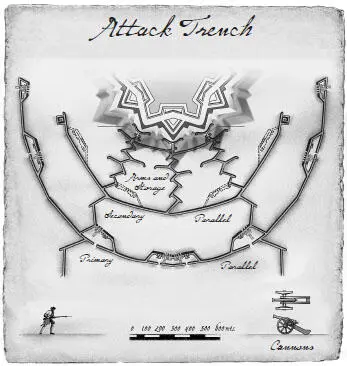That it was just the two of us permitted an act of intimacy he carried out only when he was on his own or with Jeanne: He took off his wig. I already knew from Jeanne that he’d lost his hair very early in his youth, but I was so accustomed to those artificial curls that I found it difficult to contain my surprise at seeing a man before me balder than a toad.
“Logistics? Astronomical costs?” He sighed and then added, “All you need are picks and shovels. And decent men.”
And so it proved: Vauban’s siege method was based on something as simple and straightforward as pick and shovel.
Once the surrounding fence had been established, the engineers would decide on the point of attack. The works would begin at a prudent distance, out of range of the defenders’ weapons. This act was called, altogether appropriately, “opening the trench,” and it marked the beginning of the construction of the Attack Trench.
Like jigsaw pieces beginning to slot into place, the many backbreaking sessions with the Ducroix brothers began to make sense. Because Vauban’s method consisted of nothing more than a sapping job, perfectly coordinated. See here, in all its splendor, his siege méthode .

The aim was to make an immense excavation, the so-called Attack Trench, that would lead to the bastions. To keep the sappers from being fired on by the enemy, the trench had to be deep enough to hide them. And to avoid enfilade fire, it had to run parallel to the ramparts. The initial trenches were therefore named “parallels.” Three parallels, connected by linking culverts in zigzag, would be enough to reach the ramparts. The work would assume a very distinctive appearance. To take on a perfectly designed fortress, the perfect trench.
Never have such immortal works been so ephemeral. A large trench could be titanic in size and, once finished, would simply disappear, swallowed up by not being used. In a number of months, rain, mud, and disuse would see it buried in the mud, forgotten. Racine himself was once sent as a reporter to one of Vauban’s sieges. “There are more corners in one of our great Attack Trenches,” he wrote admiringly, “than in all of Paris.” And at the very instant the city conceded defeat, the life of the trench was at an end.
Logically enough, an Attack Trench required impeccable command of each of the sciences imparted to me in Bazoches. All in all, it would mean thousands of men working together in a coordinated way. The trench had to be wide enough for an entire army to be able to move around inside, and that meant the removal of millions of square feet of earth, with pinpoint accuracy and orderliness. The floor and walls were lined with pieces of wood to prevent landslides and flooding. A siege meant the felling of an entire forest! Munitions stores were located in the second line of trenches. Large enclosed spaces would be dug out in certain places with the sole aim of creating refuges for the cannons and mortars whose task it was to punish the point of attack and the defenders’ cannons. And when the moment came, the third parallel would become the launch point for the assault.
Imagine a trench advancing not along the exact route laid out for it but going off on a tangent of a few degrees. What would happen in such a case? Nothing serious, if we forget about the sappers not digging in parallel to the ramparts, who would be exposed; that is, from the fortress, the vanguard sappers could be seen, and they would find themselves riddled by enemy fire.
Not the ideal situation, wouldn’t you say? I’ve been on one side or the other dozens of times, and if there is a competent officer in the bastion, the most minor error in the progress of the works won’t go unpunished. Usually, a sniper will spill the brains of the poor dupe digging away in the open. But as I say, an attentive, observant officer, efficient and highly intelligent (like yours truly), would leave it a day before doing anything, holding fire as the badly dug trench advanced so ill-advisedly, leaving more and more of the men exposed in the open furrow.
The vanguard sappers might have noticed the parallel trench going off track, no longer parallel but perpendicular. And from the nearest bastion, one of the entire trench lines, and all these muddy little ants carrying wicker baskets of earth, comes into full sight. But the engineer on duty, putting his feet up in his rearguard cabin, ignores the warning, refuses to concede he’s done anything wrong. Blueprints are blueprints, and after all, though the French have recently chopped off their king’s head, the society in which we live is still governed by class. Am I wrong?
Except for those educated by a good Maganon, engineers were spoiled, arrogant brats from some important family, severely indisposed to listening to their inferiors. Well, bear in mind that I received my education from the best of the best, and therefore, I naturally consider the vast majority of military engineers for what they are: a band of savages so inept they couldn’t find their own rump if they used both hands.
Up on our bastion, looking through the telescope and seeing the peons working with pick and shovel on a trench that has strayed off track, the moment has come to act. Rifle fire? Well, of course not. While the enemy worsens his error, you transfer three wide-bore cannons into position on the bastion wall.
Into one of these, pack a five-kilo ball; into the other two, grapeshot. And adjust the range. First land one fifteen feet to the left of the furrow, then another the same distance to the right. Everything’s ready — though the sappers have no idea. First because they’re keeping their heads down behind the brushwood breastwork; second because, in the midst of the general harassment, the rifle fire from both sides, the continual exchange of rockets and grenades, the cries of the wounded and the screen of smoke cloaking no-man’s-land, it would never occur to the poor idiots that the two explosions have anything to do with them. And so, when a lot of people are gathered there, on the perpendicular that never should have been, you give the order for all three cannons to fire at once.
Ten sappers explode into ten thousand pieces. The trench is furrowed, and the impact is so powerful that their remains won’t embed into the far wall but will be blasted back the length and breadth of the trench. The shreds of bone, meat, and viscera will likely spread out over an area of more than five hundred feet.
Much is gained from this. Imagine now the morale of the survivors when the nincompoop engineer sitting in his little cabin says, “Dear Lord, what poor luck,” before ordering them to get back to it — all of a sudden they’re three days behind schedule. Desertions may follow, some might even rebel; in any case, the siege is delayed. And when you are the defender, you have one objective: to play for time.
Meanwhile, the unfortunate sappers have to go back to their work, advancing on all fours. And the lovely spectacle accompanying them is that of walls coated with pieces of their friends, fragments of cranium, ribs, and femurs split like pieces of cane. Human intestines, by the way, have a tendency to stick to the wooden uprights in a trench like boiled noodles to a wall. .
You, stop your whinging and write ! Did you not say you liked the epic tone, all that rot? Well, here’s epic for you.
But the example I have just given is hardly worthy of Vauban’s genius. If his method were rigorously followed, the defenders would never be presented with such opportunities. He never made a single mistake. Under his command, the parallels advanced implacably, at great speed, as though an army of termites were doing the work. Within a week, two at a stretch, he could be within sixty feet of any rampart. And at that distance, with the trench so close, the besieger had the upper hand.
Читать дальше













